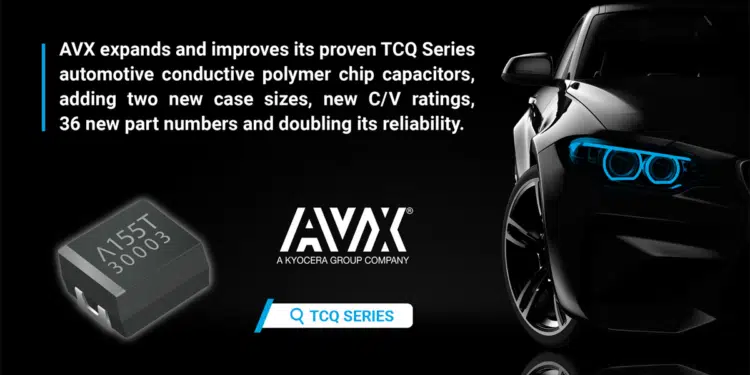AVX expands and improves its proven TCQ Series Automotive Conductive Polymer Chip Capacitors, adding two new case sizes, new C/V ratings, add 36 new part numbers and doubling its reliability.
Now available in five miniature, low-profile case sizes with capacitance and voltage ratings spanning 10–470μF and 2.5–50V, AVX’s AEC-Q200-qualified TCQ Series capacitors — field-proven in a wide range of demanding applications since 2015 — also deliver double the operational life required in the AEC-Q200 specification, 2,000 hours at 125°C.
AVX Corporation, a leading manufacturer and supplier of advanced electronic components and interconnect, sensor, control, and antenna solutions, has both expanded and improved upon its AEC-Q200-qualified TCQ Series Automotive Conductive Polymer Chip Capacitors, which have been field-proven in a wide range of demanding automotive, industrial, and telecommunications applications with limited board space and challenging operating environments since 2015. The series now offers two new case sizes for a total of five, several new capacitance and voltage (C/V) ratings, 36 new part numbers for a total of 52, and twice the reliability specified in AEC-Q200.
AVX’s TCQ Series capacitors have a compact and robust form factor that’s ideally suited for space-constrained, harsh-environment applications including body electronics, cabin controls, comfort and infotainment systems, aftermarket automotive electronics, DC/DC converters, and coupling/decoupling, and are equipped with conductive polymer electrodes that enable a benign failure mode under recommended use conditions. Previously available in just three miniature, low-profile case sizes — “B” (EIA Code 1210 or EIA Metric 3528-21), “D” (2917 or 7343-31), and “Y” (2917 or 7343-20) — the TCQ Series now offers “E” (2917 or 7343-43) and “U” (2924 or 7361-43) case sizes as well, for a total of five form factors. The series has also been expanded to include 36 new part numbers covering a newly extended range of capacitance and voltage ratings. It now offers 52 unique part numbers with C/V ratings spanning 10–470μF and 2.5–50V with a ±20% capacitance tolerance, which is a significant improvement over the previous range of 10–220μF (±20%) and 4–35V with just 16 unique part numbers.
TCQ Series Automotive Conductive Polymer Chip Capacitors exhibit low DC leakage (0.1CV), high capacitance, and stable electrical performance in operating temperatures extending from -55°C to +125°C. They also satisfy AEC-Q200 humidity bias testing requirements (Ur at 85°C and 85% RH for 1,000 hours) due to materials, design, and manufacturing innovations AVX employed to overcome the inherent limitations of polymer materials — a feat that few capacitor suppliers have accomplished — and deliver exceptional endurance and stability for 2,000 hours at 125°C, exceeding the already-stringent AEC-Q200 operational life requirement by 100%.
“Our newly expanded range of TCQ Series Automotive Conductive Polymer Chip Capacitors offers significantly more solutions for space-constrained, harsh-environment applications in the automotive, industrial, and telecom markets than the initial market release and has undergone extensive testing to verify that it meets or, in terms of operational lifetime, exceeds AEC-Q200 stress test qualifications,” said Allen Mayar, AVX Tantalum Capacitors product marketing manager. “TCQ Series capacitors have a conservative design with superior resistance to humidity and improved reliability, are qualified to AEC-Q200, and provide field-proven performance in a variety of demanding application areas.”
TCQ Series capacitors exhibit basic reliability of 1% per 1,000 hours at 85°C and rated voltage with 60% confidence. They are also 3x reflow compatible at 260°C, lead-free compatible, and RoHS compliant, and are manufactured in an IATF 16949 certified facility. Parts are supplied with pure tin terminations on 7” or 13” reels, and standard lead-time is approximately 20 weeks.
































